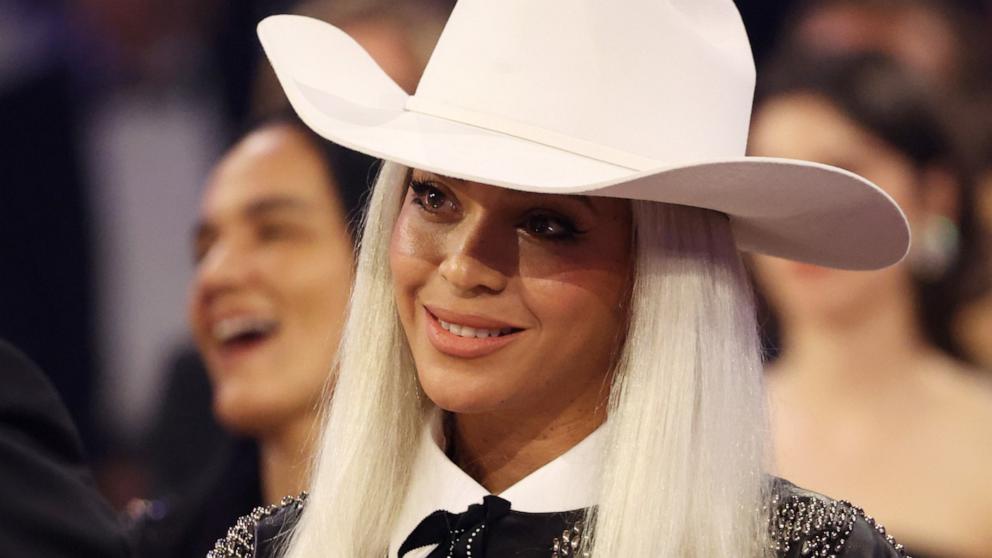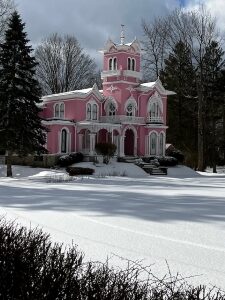Beyoncé’s musical renaissance continues on March 29, with the drop of her country-inspired album “Cowboy Carter.”
The Houston, Texas, native is expected to not just honor her country roots, but also to highlight the historical and ongoing contributions Black artists have made to the genre that some say has long shut them out.
In a statement on Beyoncé’s social media earlier this month regarding “Cowboy Carter,” she said her new album was “born out of an experience I had years ago where I did not feel welcomed … and it was very clear that I wasn’t.”
Many speculated that she was speaking about the backlash and racism she experienced after her 2016 performance of her country song “Daddy Lessons” at the Country Music Awards with The Chicks, who were known as the Dixie Chicks at the time.
“The criticisms I faced when I first entered this genre forced me to propel past the limitations that were put on me,” Beyoncé said. “Act ii is a result of challenging myself, and taking my time to bend and blend genres together to create this body of work.”
For 64-year-old country songwriter and publisher Alice Randall, a Black woman with a long career in the country industry, she feels the “Carter Cowboy” album was “good news at long last.”
“My last dream was, I wanted to live to see a Black woman at the top of the country charts because I had never seen it,” said Randall, who became the first Black woman to write a No.1 country hit in 1994, in an interview with ABC News. “I thought I would be retiring at 65 and not see it” until Beyoncé’s latest single came along.
Beyoncé’s “Texas Hold ‘Em” single debuted at No. 1 on Billboard’s Hot Country Songs chart in February.
Despite the contributions of Black artists to the roots of the genre, research shows that Black artists have largely been shut out of the industry.
For example, in 19 years of country radio programming, only 13 Black artists were represented among the 11,484 songs played by major country stations, according to a study from the Black Music Action Coalition. Only three Black artists have been inducted into the Country Music Hall of Fame since 1964.
“Black folks had been in country music from the beginnings of the genre,” Francesca Royster, author of “Black Country Music,” told ABC News in an interview.
The sounds of country
The banjo was created by enslaved Africans and their descendants in the Caribbean and North America by combining African and European instrument forms, according to The Smithsonian Institution, and has since become a staple in country, folk and hillbilly music.
The fiddle, which can be traced to various cultures, was performed using West African techniques that would influence Southern Appalachian fiddling styles, according to the U.S. National Park Service.
The songs sung by enslaved people – their hymns and spirituals – also influenced the music of the South.
“They were often required to perform to entertain whites on plantations and would also be sent by their owners to travel to other plantations or social events as entertainment, further spreading musical Africanisms across the American South,” the U.S. National Park Service found.
The popularity and widespread reach of blackface minstrelsy, “where white artists were playing Black music in blackface,” also played a role in the later inspiring what would become staples of country music’s sound, said Royster.
“The prehistory of country music includes Black folk music and includes Black string bands. It includes vaudeville, and blackface minstrelsy,” Royster said. “All of these really mixed up roots are part of what became the sound of country music.”
Black mentors inspired country’s greats
The foundations of some of country music’s biggest names – The Carter Family, Johnny Cash, Hank Williams– were also influenced by relatively unknown Black figures such as Lesley Riddle, Gus Cannon, and Rufus “Tee Tot” Payne, according to documentarian and historian Ken Burns.
Riddle traveled with the Carter family, teaching them his techniques and helping shape their sound and songs, according to the Birthplace of Country Music Museum.
“The things the Carter family played benefited not only from just a white musical tradition in the Appalachians but from a Black musical tradition in the Appalachians,” said Burns. “The Carter family wouldn’t be the first family of country music without Lesley Riddle and his additions.”
Hank Williams, Sr. and Hank Williams Jr. have long acknowledged the importance of Payne, an unknown Black street musician, in mentoring Williams Sr.
In the book “Sing a Sad Song: The Life of Hank Williams,” author Roger Williams says that Payne would walk around singing for money, and Williams would follow him around as a young man, learning how to play from Payne.
“All the music training I ever had was from him,” Williams Sr. said in a 1951 interview, according to the Los Angeles Times.
Williams Jr. has a song called the “Tee Tot Song” in his honor – “Met this white boy little Hiram Hank / Took him in right under his wing … If I could play just like you /Why, I’d give anything.”
Johnny Cash met successful blues musician Gus Cannon on the streets of Memphis while working at a home appliance store.
In a 1997 interview, he mentions his influence: ”Gus Cannon, the man who wrote ‘Walk Right In’ which was a hit for the Rooftop Singers, and I sat on the front porch with him, day after day, when I found him, and sing those songs.”
“You begin to appreciate how central Black influence has always been on country music and as much as commerce and convenience segregates it, you cannot because the musicians don’t,” said Burns.
Black artists try to flourish in industry
Despite Black artists playing a collaborative role in what country music sounds like today, musicians have long faced barriers to succeeding in the industry.
“DeFord Bailey was the Opry’s first superstar. Not the first Black superstar – DeFord Bailey is arguably the Opry’s first superstar. Period,” Randall said.
But a music licensing dispute between licensing agency ASCAP – which owned all of his most popular songs – and the National Association of Broadcasters had Bailey fired from the Opry.
“He ended up shining shoes,” said Burns.
Charley Pride, a country music icon, was raised in the segregated South as the son of a sharecropper, according to the Country Music Hall of Fame and Museum. He would become the first artist of any race to win the Country Music Association’s male vocalist award two years in a row and the first Black artist to have a No.1 country record, according to the museum.
However, Pride too faced challenges – in the 1960s, his race was kept a secret from RCA Records Nashville until after his deal was signed. His race was also kept a secret from country radio disc jockeys until his songs proved regularly be successful, the museum noted.
Linda Martell became the first Black woman to perform at the Grand Ole Opry stage in the late 1960s and early 1970s, cutting an album and several country chart hits, enduring racism that she said led to the downfall of her career.
“But her label stopped investing in her after a year, they decided it was too risky,” said Royster.
Several Black artists have continued to cross genres into country music – including Ray Charles, Tina Turner and Darrius Rucker – some of whom found great success in tackling the genre.
However, Royster argues that the industry successfully “segregated country music and pushed Black artists to the margins,” and that country music has long been seen as a white, heteronormative space that feels unwelcoming for listeners from other communities.
In a study from the Black Music Action Coalition found that of the 411 artists signed to the top three Nashville label groups in Nashville from 2000-2020, only 1% were Black and 3.2% were people of color.
As more new Black country artists make their paths in the genre, Royster says there growing attempts to push back against gate-keepers who have caused the “segregation” of opportunities in the industry.
The future of country
Lil Nas X’s 2019 hit single, “Old Town Road,” and the controversy around it is a key example of the ongoing debate about what country music looks like in today’s world.
The song, a blend of rap and country, debuted on Billboard’s country chart at No. 19 – but in less than a week, it was removed.
Billboard told Rolling Stone at the time that the track “does not embrace enough elements of today’s country music to chart in its current version.”
But researchers point out that when other country stars blur the lines between country and other genres like rock or pop or hip-hop – like Florida Georgia Line – there’s a stark difference in their reception in the industry.
Randall called it “cultural redlining.”
“We are keeping certain people out of certain spaces and my question is: why?” Randall said. “A large percentage of cowboys look just like Lil Nas X … and you should be grateful for his art, ‘Old Town Road’ that introduced you to that reality. I think that America will come to a better understanding of herself.”
Burns said that Beyoncé’s new album has the potential to make a difference in the way people see country music.
“There’ll be some people whose minds are changed, just as DeFord Bailey changed minds, just as Charlie Pride changed minds, just as Rhiannon Giddens and Lil Nas X have,” said Burns. “Maybe not everybody, but you work on a few and you win a few and you lose a few. And hopefully, the war is ultimately won by the good guys.”







